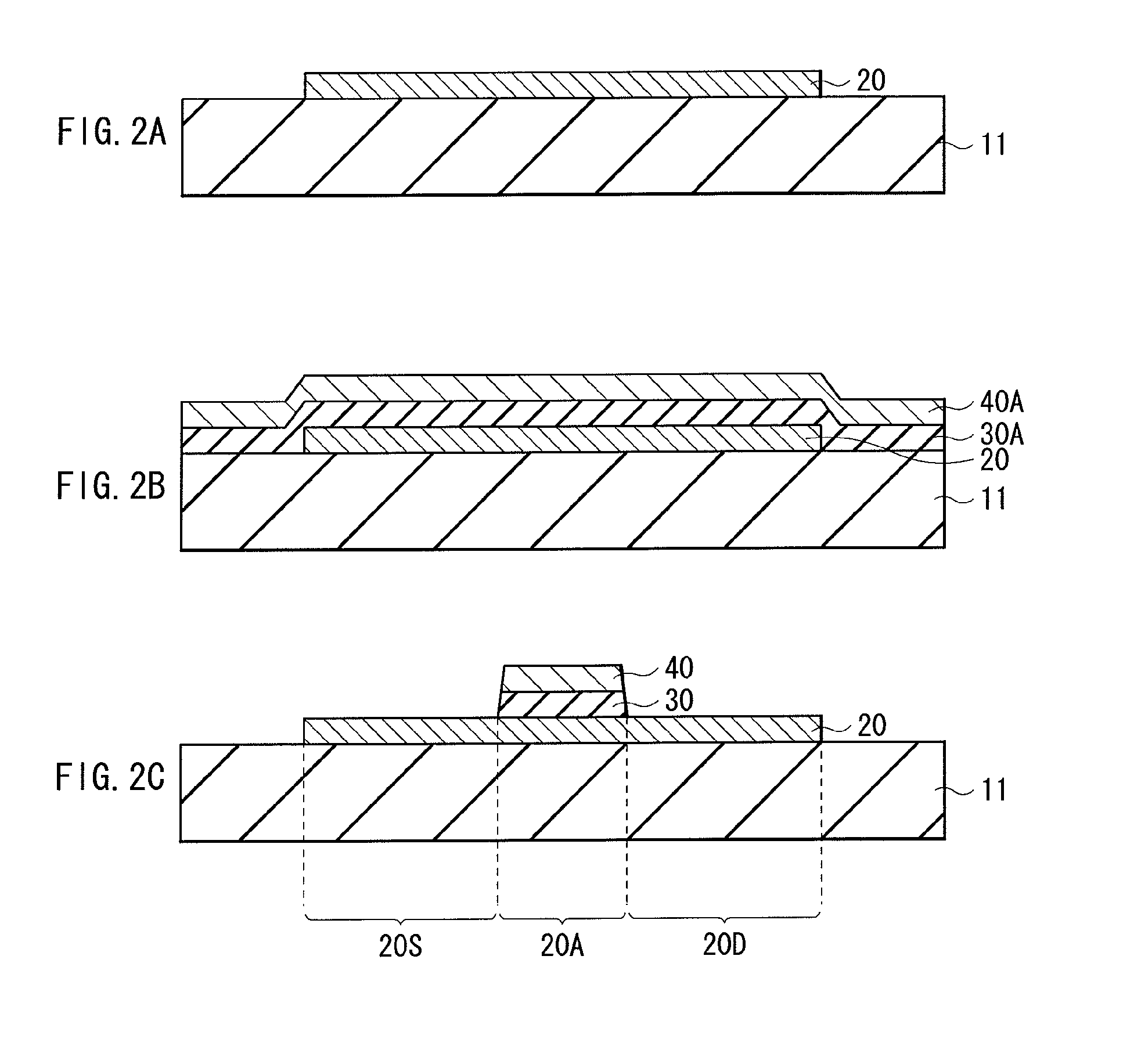Thin-film transistor, method of manufacturing the same, and display device
a technology of thin film transistors and transistors, which is applied in the direction of transistors, semiconductor devices, electrical devices, etc., can solve the problems of more chance of short-circuit between wirings, increased risk of short-circuit, and fluctuation of voltage, so as to improve the quality of display, stabilize the characteristic, and reduce the parasitic capacitance
- Summary
- Abstract
- Description
- Claims
- Application Information
AI Technical Summary
Benefits of technology
Problems solved by technology
Method used
Image
Examples
first embodiment
[0104]FIG. 1 illustrates a cross-sectional configuration of a thin-film transistor 1 according to a first embodiment. The thin-film transistor 1 may be used as a drive element in a device such as a liquid crystal display and an organic EL display. The thin-film transistor 1 may have a top-gate structure (or a staggered structure), in which an oxide semiconductor film 20, a gate insulating film 30, a gate electrode 40, a high-resistance film 50, an interlayer insulating film 60, a source electrode 70S, and a drain electrode 70D are stacked in this order on a substrate 11, for example.
[0105]The substrate 11 may be configured by a glass substrate, a plastic film, or other suitable member, for example. A material of a plastic can be polyethylene terephthalate (PET), polyethylene naphthalate (PEN), or other suitable material. The plastic film, which is inexpensive, may be used in order to deposit the oxide semiconductor film 20 without heating the substrate 11 in a later-described sputte...
second embodiment
[0141]A thin-film transistor according to a second embodiment has a similar configuration as that of the thin-film transistor 1 according to the first embodiment illustrated in FIG. 1, except that a configuration and a manufacturing method of the low-resistance region 21 are different from those in the first embodiment described above. Note that the same or equivalent elements as those according to the first embodiment are denoted with the same reference numerals, and will not be described in detail. Also, process steps corresponding to those in the first embodiment will be described with reference to FIGS. 1 to 3C.
[0142]In the thin-film transistor according to this embodiment, the low-resistance region 21 is made low in resistance by containing one or more elements selected from a group including aluminum (Al), boron (B), gallium (Ga), indium (In), titanium (Ti), silicon (Si), germanium (Ge), tin (Sn), and lead (Pb) as a dopant. Thin-film transistor 1 is thereby able to have the se...
third embodiment
[0159]FIG. 9 illustrates a cross-sectional configuration of a thin-film transistor 1B according to a third embodiment. The thin-film transistor 1B has a similar configuration as that of the thin-film transistor 1 according to the first embodiment described above, except that the thin-film transistor 1B is a bottom-gate thin-film transistor in which the gate electrode 40, the gate insulating film 30, the oxide semiconductor film 20, a channel protecting film 80, the interlayer insulating film 60, the source electrode 70S, and the drain electrode 70D are stacked in this order on the substrate 11. Note that the same or equivalent elements as those according to the first embodiment are denoted with the same reference numerals, and will not be described in detail.
[0160]The channel protecting film 80 is provided on the channel region 20A of the oxide semiconductor film 20. The channel protecting film 80 may have a thickness of about 200 nm, and may be configured of a monolayer film, which...
PUM
 Login to View More
Login to View More Abstract
Description
Claims
Application Information
 Login to View More
Login to View More - R&D
- Intellectual Property
- Life Sciences
- Materials
- Tech Scout
- Unparalleled Data Quality
- Higher Quality Content
- 60% Fewer Hallucinations
Browse by: Latest US Patents, China's latest patents, Technical Efficacy Thesaurus, Application Domain, Technology Topic, Popular Technical Reports.
© 2025 PatSnap. All rights reserved.Legal|Privacy policy|Modern Slavery Act Transparency Statement|Sitemap|About US| Contact US: help@patsnap.com



